
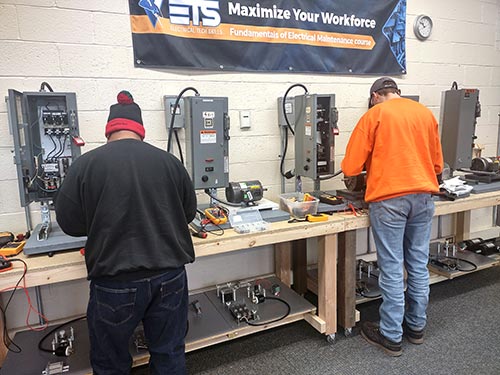
Save valuable time and money with qualified technicians
With ETS’ Fundamentals of Electrical Maintenance training, your technicians will develop the skills necessary to effectively troubleshoot and safely repair the plant’s equipment as needed.
This reduces the need for costly part replacements, minimizes the need for technical support, and prevents equipment damage due to incorrect installation or substandard workmanship.
Who should attend Fundamentals of Electrical Maintenance training?
- Experienced electricians who need to sharpen their skills or gain new knowledge.
- Electricians that are new to the craft or are transitioning from the construction trade to an industrial setting.
- Multi-craft workers who need to develop the skills to perform electrical trouble shooting and repair accurately and safely.
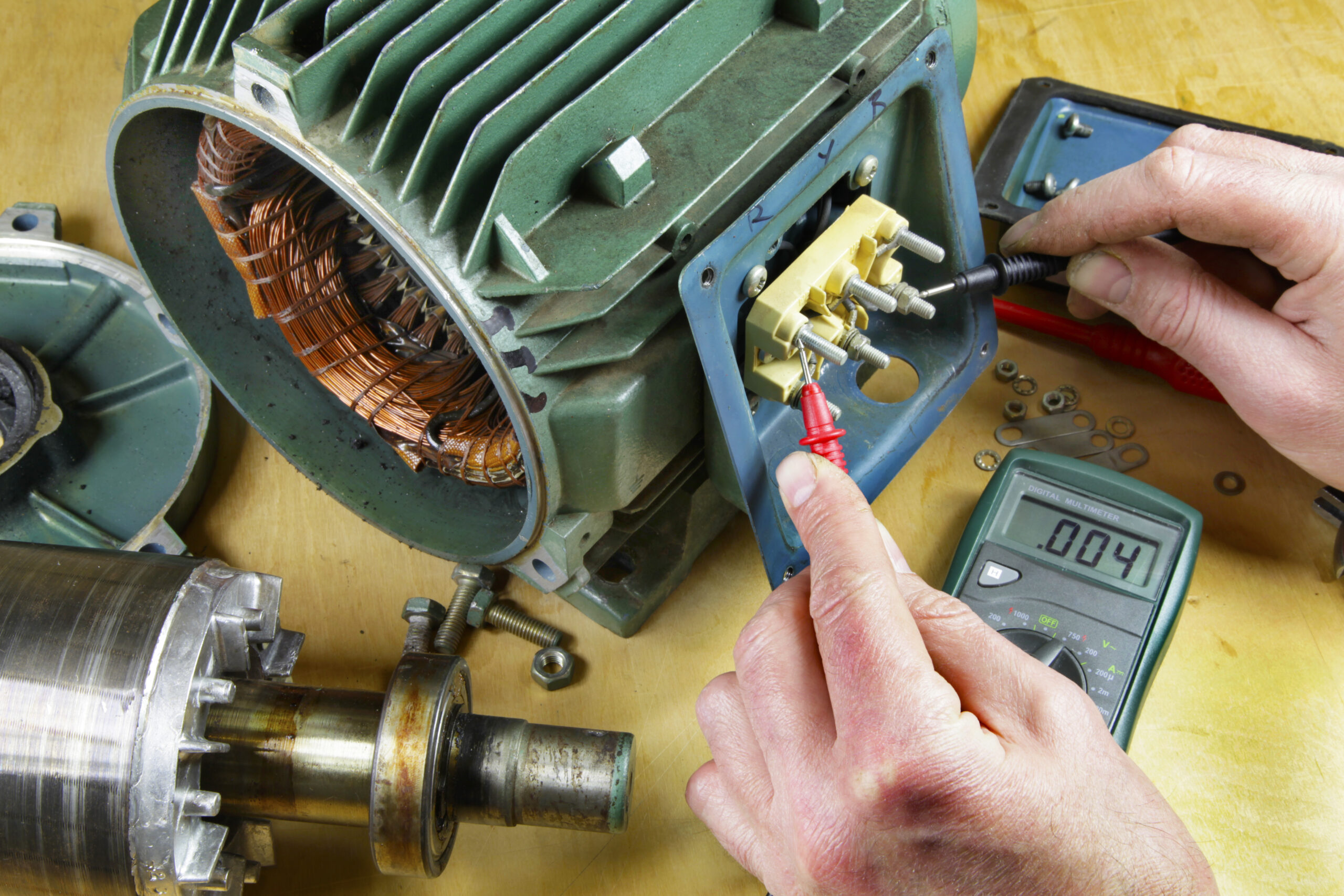
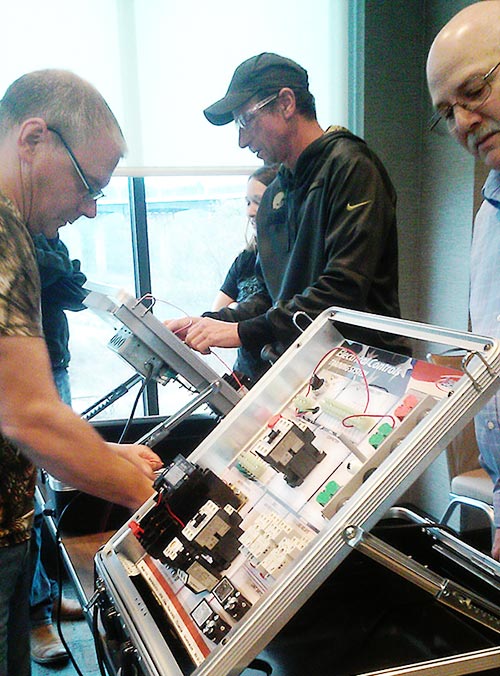
Fundamentals of Electrical Maintenance
Class format
This is a 4-day course that consists of classroom and hands-on electrical maintenance training including safe electrical work practices. When the course is complete, the students will be able to perform fundamental electrical maintenance troubleshooting and repair tasks safely and accurately.
Class size
Up to 10 students can be trained at our location in each class. A company may reserve an entire class, or send individuals to our public classes. Click below for a detailed class outline.
Each training day runs from 8am – 4pm.
Course modules/details
Module 1: Basic Electrical Theory
The lesson material will be a combination of classroom lecture and hands-on exercises that start with electrical basic theory and finish with more advanced troubleshooting concepts. The students will use breadboards to
build circuits, take volt, ohm and current measurements that will verify their previously calculated values. At the completion of this module the student will be able to identify common circuit malfunctions such as opens and shorts utilizing test instruments.
Understand Basic Electrical Concepts
• Basic atomic structure
• Direct Current (DC)
• Alternating Current (AC)
• Volts / Ohms / Amps
• Insulators / Conductors
• Ohm’s law
• Circuit Construction
• Basic Troubleshooting Techniques
Use and Limitations of Test Equipment
• Volt Meters
• Ohm Meters
• Amp Meters
Module 2: Alternating Current
At the completion of this module, the student will understand what alternating current is, how it works, and what factors affect the operation and maintenance of AC equipment such as motors, transformers, and distribution equipment.
Learning Outcomes
• Describe single and three-phase alternating current
• Understand how alternating current is generated
• Explain the principals of electromagnetism
• Explain how current flow and polarity change in AC circuits
• Explain what frequency is and how it is measured
• Define peak value, peak-to-peak value, and effective value with respect to AC voltage and current
• Explain the difference between single-phase and three-phase AC systems
• Explain how a three-wire single-phase AC system supplies two different voltages
• Differentiate between delta-connected and wye-connected three-phase AC systems
• Calculate line and phase voltage
Module 3: Transformers
Electric transformers are utilized in most electrical equipment. Transformers can either step-up or down voltages to provide a safer level for equipment controls that will be interacted with by plant employees. Even though
transformers do not contain any moving parts they can fail due to improper maintenance or overloading. This module will explain how a transformer operates, how to determine the correct size, and identify common malfunctions.
Learning Outcomes
• Explain how a transformer operates
• Identify common uses of transformers
• Describe the components that make-up a transformer
• Determine the turns ratio of a transformer
• Compare and contrast three-phase and single-phase transformers
• Read transformer nameplate information
• Explain transformer wye and delta configurations
• Calculate phase and line voltages
• Determine transformer sizing based on load
• Calculate short circuit current
• Discuss transformer malfunctions
Module 4: Electrical Motor Operation and Troubleshooting
This module starts with the basics of electric motors and control techniques thorough fundamental motor maintenance and identification of common electric motor failures. This module will have the students building and troubleshooting both basic and specialized motor control circuits, as well as, wiring three-phase electric motors for both high and low voltage based on the information they glean from the motor’s nameplate. The students will learn how to identify shorted and open windings by using test equipment such as volt/ohm meters and insulation resistance testers.
Learning Outcomes
• Identify the parts of an electric motor
• Explain the operation of a synchronous electric motor
• Given name plate data properly connect a three-phase electric motor
• Using test equipment identify the cause of a malfunctioning electric
motor
• Troubleshoot open and shorted motor windings
• Clean, inspect, and repair a NEMA rated motor starter
Module 5: Motor Control Wiring and Troubleshooting
This module provides the student with the necessary understanding of motor control devices such as limit switches, motor starters, and relays and their symbols used on electrical diagrams.
Students will build common motor control stop and start circuits using real world equipment from ladder diagrams. Troubleshooting techniques will be explained and performed as part of this intensely hands-on module.
Learning Outcomes
• Identify electrical components and their symbols on electrical drawings
• Read a ladder diagram and explain the operation logic
- Explain the operation of relays
- Build a 3-wire motor control circuit
- Perform basic troubleshooting of motor control circuits using test equipment
- Interpret a common MCC bucket wiring diagram
Module 6: Over Current Protection
Over Currents Protection Devices protect equipment and conductors by opening the circuit when predetermined values or parameters are met.
Over current protection devices include fuses, circuit breakers and thermal overloads. In this module, the student will learn the different types of fuses and circuit breakers, how they operate and how they protect circuits from both short circuit and overload conditions.
Learning Outcomes
• Compare and contrast a short circuit, overload, and ground fault
• Explain fuse current, voltage, and interrupt ratings
• Discuss current limiting fuse operation
• Explain rejection type fuse holders and fuses
• Explain the operation of single and dual element fuses
• Identify the components of low voltage circuit breakers
• Discuss the operation of low voltage circuit breakers
• Explain how thermal overloads operate
Module 7: Components for Electrical Construction
Industrial Electricians need a basic understanding of the National Electric Code to ensure that safety requirements are met when installing new or replacing old equipment. In this module, the student will learn the different wire types, their ampacities and how many conductors can safely be installed in conduits. Wire splicing methods will be discussed such as the safe use of twist-on connectors.
Learning Outcomes
- Compare and contrast wires and cables
- Determine a wire size base on American Wire Gauge Standards
- Determine the Ampacity of a wire in accordance with the National Electric Code
- Identify the different insulations used on common industrial wires
- Compare and contrast copper and aluminum wires
- Determine the number of wires that can be safely joined using a twist on connector
Module 8: NFPA 70E Electrical Safety Training
This Electrical Safety in the Workplace module is specifically designed to meet the NFPA 70E training requirements for employees who work on or near energized electrical equipment.
This module will provide electrical workers with the knowledge and skill needed to recognize the shock and arc flash hazards that they encounter in their daily work activities. The students will understand the decision-making process necessary to assess the associated risk, perform job safety planning, select the appropriate risk control methods, including the proper use of PPE.
Learning Outcomes
• Identify the electrical hazards present in the workplace.
• Perform the steps required to create an electrically safe work condition.
• Select the correct rating of insulating gloves
• State the requirements for performing energized work
• Describe the hazards associated with arc flash/blast events.
• Identify common arc flash hazards
• Identify the rating, use and limitations of arc flash personal protective equipment.
• Perform an arc flash and shock hazard risk assessment
Course modules/details
Module 1: Basic Electrical Theory
The lesson material will be a combination of classroom lecture and hands-on exercises that start with electrical basic theory and finish with more advanced troubleshooting concepts. The students will use breadboards to
build circuits, take volt, ohm and current measurements that will verify their previously calculated values. At the completion of this module the student will be able to identify common circuit malfunctions such as opens and shorts utilizing test instruments.
Understand Basic Electrical Concepts
• Basic atomic structure
• Direct Current (DC)
• Alternating Current (AC)
• Volts / Ohms / Amps
• Insulators / Conductors
• Ohm’s law
• Circuit Construction
• Basic Troubleshooting Techniques
Use and Limitations of Test Equipment
• Volt Meters
• Ohm Meters
• Amp Meters
Module 2: Alternating Current
At the completion of this module, the student will understand what alternating current is, how it works, and what factors affect the operation and maintenance of AC equipment such as motors, transformers, and distribution equipment.
Learning Outcomes
• Describe single and three-phase alternating current
• Understand how alternating current is generated
• Explain the principals of electromagnetism
• Explain how current flow and polarity change in AC circuits
• Explain what frequency is and how it is measured
• Define peak value, peak-to-peak value, and effective value with respect to AC voltage and current
• Explain the difference between single-phase and three-phase AC systems
• Explain how a three-wire single-phase AC system supplies two different voltages
• Differentiate between delta-connected and wye-connected three-phase AC systems
• Calculate line and phase voltage
Module 3: Transformers
Electric transformers are utilized in most electrical equipment. Transformers can either step-up or down voltages to provide a safer level for equipment controls that will be interacted with by plant employees. Even though
transformers do not contain any moving parts they can fail due to improper maintenance or overloading. This module will explain how a transformer operates, how to determine the correct size, and identify common malfunctions.
Learning Outcomes
• Explain how a transformer operates
• Identify common uses of transformers
• Describe the components that make-up a transformer
• Determine the turns ratio of a transformer
• Compare and contrast three-phase and single-phase transformers
• Read transformer nameplate information
• Explain transformer wye and delta configurations
• Calculate phase and line voltages
• Determine transformer sizing based on load
• Calculate short circuit current
• Discuss transformer malfunctions
Module 4: Electrical Motor Operation and Troubleshooting
This module starts with the basics of electric motors and control techniques thorough fundamental motor maintenance and identification of common electric motor failures. This module will have the students building and troubleshooting both basic and specialized motor control circuits, as well as, wiring three-phase electric motors for both high and low voltage based on the information they glean from the motor’s nameplate. The students will learn how to identify shorted and open windings by using test equipment such as volt/ohm meters and insulation resistance testers.
Learning Outcomes
• Identify the parts of an electric motor
• Explain the operation of a synchronous electric motor
• Given name plate data properly connect a three-phase electric motor
• Using test equipment identify the cause of a malfunctioning electric
motor
• Troubleshoot open and shorted motor windings
• Clean, inspect, and repair a NEMA rated motor starter
Module 5: Motor Control Wiring and Troubleshooting
This module provides the student with the necessary understanding of motor control devices such as limit switches, motor starters, and relays and their symbols used on electrical diagrams.
Students will build common motor control stop and start circuits using real world equipment from ladder diagrams. Troubleshooting techniques will be explained and performed as part of this intensely hands-on module.
Learning Outcomes
• Identify electrical components and their symbols on electrical drawings
• Read a ladder diagram and explain the operation logic
- Explain the operation of relays
- Build a 3-wire motor control circuit
- Perform basic troubleshooting of motor control circuits using test equipment
- Interpret a common MCC bucket wiring diagram
Module 6: Over Current Protection
Over Currents Protection Devices protect equipment and conductors by opening the circuit when predetermined values or parameters are met.
Over current protection devices include fuses, circuit breakers and thermal overloads. In this module, the student will learn the different types of fuses and circuit breakers, how they operate and how they protect circuits from both short circuit and overload conditions.
Learning Outcomes
• Compare and contrast a short circuit, overload, and ground fault
• Explain fuse current, voltage, and interrupt ratings
• Discuss current limiting fuse operation
• Explain rejection type fuse holders and fuses
• Explain the operation of single and dual element fuses
• Identify the components of low voltage circuit breakers
• Discuss the operation of low voltage circuit breakers
• Explain how thermal overloads operate
Module 7: Components for Electrical Construction
Industrial Electricians need a basic understanding of the National Electric Code to ensure that safety requirements are met when installing new or replacing old equipment. In this module, the student will learn the different wire types, their ampacities and how many conductors can safely be installed in conduits. Wire splicing methods will be discussed such as the safe use of twist-on connectors.
Learning Outcomes
- Compare and contrast wires and cables
- Determine a wire size base on American Wire Gauge Standards
- Determine the Ampacity of a wire in accordance with the National Electric Code
- Identify the different insulations used on common industrial wires
- Compare and contrast copper and aluminum wires
- Determine the number of wires that can be safely joined using a twist on connector
Module 8: Variable Frequency Drive Operation and Troubleshooting
A Variable Frequency Drive (VFD) is a type of motor controller that drives an electric motor by varying the frequency and voltage supplied to the electric motor.
In this module, the student will learn how a VFD operates, how to install inputs and output for proper operation, program various parameters, and troubleshoot malfunctions by retrieving and deciphering fault codes. This is a hands-on module in which the students will install, program, operate and troubleshoot real world VFD applications.
Learning Outcomes
• Explain the basic theory and applications of Variable Frequency Drives
• Explain Internal operation of a VFD
• Describe the Installation and maintenance requirements
• Perform installation of real-world field I/O controls
• Explain 0-10v & 5-20ma signal generation and input
• Perform VFD basic Programming
• Identify parameters and settings
• Troubleshooting the VFD and Field I/O
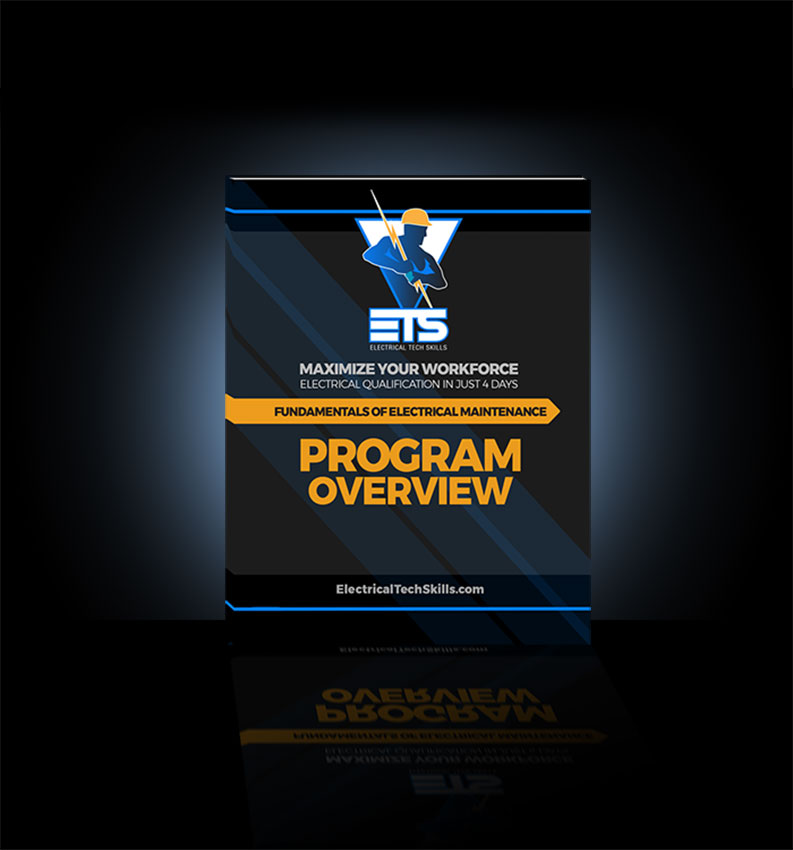
Unlock the Power of Expert Electrical Maintenance: Get Your FREE Comprehensive PDF!
Are you ready to empower your technicians with the essential skills for efficient electrical maintenance? Discover our FREE PDF, an in-depth outline of “The Fundamentals of Electrical Maintenance” course’s 9 enriching modules.
This dynamic overview will be immediately delivered to the email address you provide.
Backed by the seasoned professionals at ETS, this course is meticulously designed to cultivate safe and technically proficient technicians. As leaders in electrical training, we’re committed to enhancing your team’s capabilities.
Available Classes
Sign up before they fill up!
Note: Each training day runs from 8am – 4pm
What they’re saying about our Fundamentals of Electrical Maintenance Class
Latest Electrical Maintenance Article

Cut Costs, Not Corners: Why Electrical Skills Are Your New Profit Center
In today's fast-paced manufacturing world, every penny counts. What if there was a way to slash costs, boost productivity, and supercharge your bottom line all at once? Enter the unsung hero of modern factories: electrical maintenance training. Imagine a workforce...
Cut Costs, Not Corners: Why Electrical Skills Are Your New Profit Center
In today's fast-paced manufacturing world, every penny counts. What if there was a way to slash costs, boost productivity, and supercharge your bottom line all at once? Enter the unsung hero of modern factories: electrical maintenance training. Imagine a workforce that can swiftly tackle...
5 Essential Updates in NFPA 70e’s 2024 Edition
OSHA and the good folks at NFPA are always trying to reduce annual injuries (and worse) due to electrical incidents in the workplace. We take these updates very seriously at ETS and update our training accordingly. We're giving you a summary of the important changes to the 2024 edition of NFPA 70e...
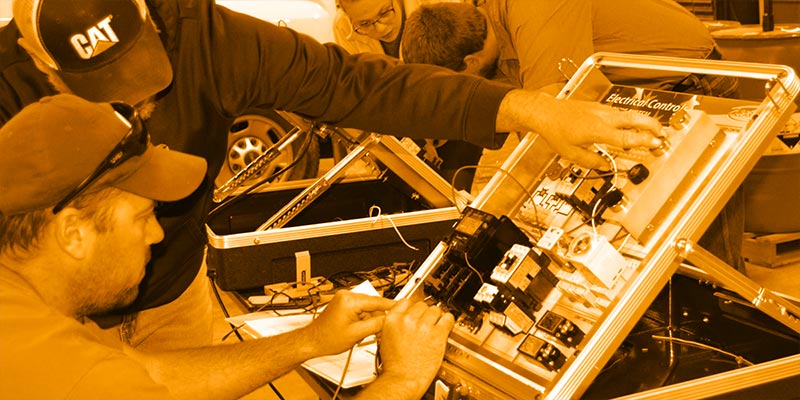
5 Essential Updates in NFPA 70e’s 2024 Edition
OSHA and the good folks at NFPA are always trying to reduce annual injuries (and worse) due to electrical incidents in the workplace. We take these updates very seriously at ETS and update our training accordingly. We're giving you a summary of the important changes...


